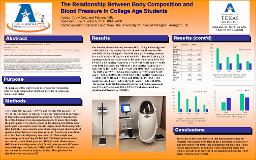
ATTENTION: The works hosted here are being migrated to a new repository that will consolidate resources, improve discoverability, and better show UTA's research impact on the global community. We will update authors as the migration progresses. Please see MavMatrix for more information.
Show simple item record
| dc.contributor.author | Ortiz, Arely | |
| dc.contributor.author | Villari, Fabiana | |
| dc.date.accessioned | 2019-04-09T23:13:41Z | |
| dc.date.available | 2019-04-09T23:13:41Z | |
| dc.date.issued | 2018-12 | |
| dc.identifier.uri | http://hdl.handle.net/10106/27933 | |
| dc.description | KINE 4400 | |
| dc.description.abstract | **Please note that the full text is embargoed** ABSTRACT: INTRODUCTION: Body composition is divided into two components: fat-free mass and fat mass. Fat-free mass includes organs, muscles, bones, blood, and skin which is chemically broken down into water, protein, and bone mineral. Whereas, fat mass would be considered essential or stored fat. A common way to measure body composition is to determine percent of body fat or body mass index (BMI). Many studies suggest that BMI is associated with blood pressure. Unlike measuring percent body fat, BMI does not consider fat-free mass and instead uses the ratio of total body weight to height. Considering fat-free mass when associated to blood pressure could possibly make a significant difference.
PURPOSE: The purpose of this study was to determine the relationship between body composition and blood pressure in college-age females and males.
METHODS: Ten women (W; age 23.6 + 3.9 yrs) and ten men (M; age 23.5 + 2.7 yrs) of the University of Texas at Arlington, volunteered to participate in this study. Each participant was asked to rest for 5 minutes then their blood pressure was measured manually. To assess their height, the participants were asked to stand on the stadiometer. Before each participant was asked to enter the Air Displacement Plethysmography (Bod Pod), they were asked to wear either compression shorts made of spandex and/or lycra or a one piece swimsuit. A swim cap was placed over their hair and all jewelry was removed. Their weight was measured prior to entering the Bod Pod. The blood pressure values such as the systolic blood pressure (SBP), diastolic blood pressure (DBP), mean arterial pressure (MAP), and pulse pressure (PP) were compared to percent body fat (%BF) and BMI. Both t-tests and correlations were used to analyze the data. The alpha level for significance was set at p < 0.05.
RESULTS: For females, the relationship between SBP (117.9 + 8.9 mmHg) and %BF (35.4 ± 9.1%) resulted in r = 0.28 and r =0.55 between SBP and BMI (27.5 + 4.6 kg/m2) . The DBP (70.6 + 7.9 mmHg) resulted in r = 0.21 with % BF and r = 0.63 with BMI. The MAP (86.4 + 7.8 mmHg) resulted in r = 0.25 with % BF and r = 0.64 with BMI. The PP (47.3 + 5.8 mmHg) resulted in r = 0.15 with % BF and r = -0.006 with BMI. For males, the SBP (125 + 13.43mmHg) resulted in r = -0.26 with % BF (17.3%) and r = 0.29 with BMI (26.5 + 2.5 kg/m2). The DBP was (79.7 + 10.3 mmHg) resulted in r = 0.16 with % body fat and r = 0.66 with BMI. The MAP (94.8 + 10.3 mmHg) resulted in r = -0.008 with % body fat and r = 0.56 with BMI. The PP (45.3 + 10.5 mmHg) resulted in r = -0.49 with % body fat and r = -0.27 with BMI. The percent body fat determined from the Bod Pod measurement was 17.28 ± 6.7% (M) and 35.4 ± 9.1% (W) which resulted in a significant difference (p = 0.0001).
CONCLUSION: The results of this study indicated that blood pressure did not correlate with percent body fat, but had a moderate to moderately high correlation with BMI when comparing both male and female college-aged students. In addition, percent body fat was significantly different when comparing males and females which agrees with previous research. | en_US |
| dc.description.sponsorship | Faculty Sponsor: Judy R. Wilson | en_US |
| dc.language.iso | en_US | en_US |
| dc.publisher | The University of Texas at Arlington | en_US |
| dc.subject | Body composition | en_US |
| dc.subject | Blood pressure | en_US |
| dc.subject | College-age students | en_US |
| dc.title | The Relationship Between Body Composition and Blood Pressure in College Age Students | en_US |
| dc.type | Presentation | en_US |
| dc.publisher.department | Department of Kinesiology | |
Files in this item
- Name:
- Ortiz and Villari poster_.pdf
- Size:
- 1.339Mb
- Format:
- PDF
- Description:
- PDF
This item appears in the following Collection(s)
Show simple item record


